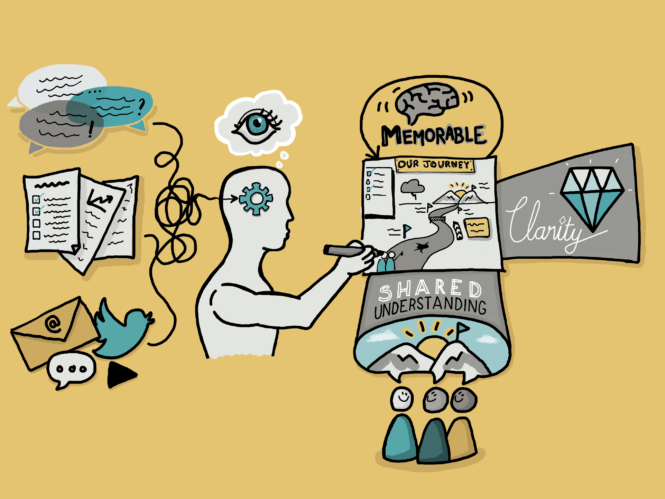
Grant Wright facilitated a half day workshop at the European Business Analysis conference 2020 on Unleashing the power of visual thinking. Grant actively practices Visual Thinking throughout his work and is passionate about its ability to create alignment, improve understanding and generate creative ideas. I caught up with him after the conference to ask him some questions about how he discovered visual thinking, it’s benefits and tips for giving it a go.
- So tell us a little about your background and career path?
My first proper job was working as a Risk and Information Analyst for a cheque guarantee company (back in the days when people actually used to use cheques to pay for things!). I didn’t know it at the time, but I was already on my path to becoming a business analyst (BA) by identifying stakeholder needs and translating these into reporting solutions and risk control processes.
When I decided to move on I saw a BA role advertised with a local software house and although I didn’t have any direct BA experience I somehow managed to get the job. That is where I ‘cut my teeth’ as a BA, developing my core skills and knowledge ‘on the job’ as different challenges were thrown at me. It was a small company so I also dabbled in other areas such as testing, pre-sales and project management before eventually progressing to become a Business Consultant/Architect, where I took a more holistic view of the problems the company was trying to solve rather than focusing on specific IT projects.
About 15 years ago I decided to pluck up the courage to set up in business on my own and established Scarlett Solutions, a boutique consultancy firm specialising in Business Analysis, Business Architecture and change delivery. Since then I have broadened both mine and my company’s skill set to include disciplines such as Agile Product Management, Business Change Management, User/Customer Experience (UX/CX) and Service Design. More recently I have focused on helping organisations to amplify their change delivery practices through the use of Visual Thinking.
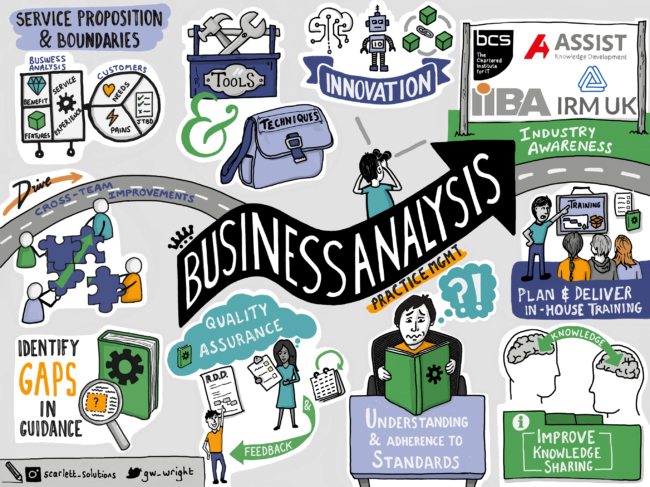
- What is visual thinking and sketchnoting?
Sketchnoting is a form of visual note-taking that combines simple drawings with text and hand-drawn typography in a way that makes content more engaging and easier to recall. You can also include metaphors and other visual elements such as arrows, lines and container shapes to reinforce key messages and help organise the information in a more meaningful way.
I see Visual Thinking as a broader term that encompasses Sketchnoting as well as other visualisation techniques and methods that help us to work smarter and think in a different way. In its simplest form Visual Thinking is about seeing things in your mind’s eye and then externalising your thoughts in a visual way in order to aid understanding, explore problems and communicate more effectively.
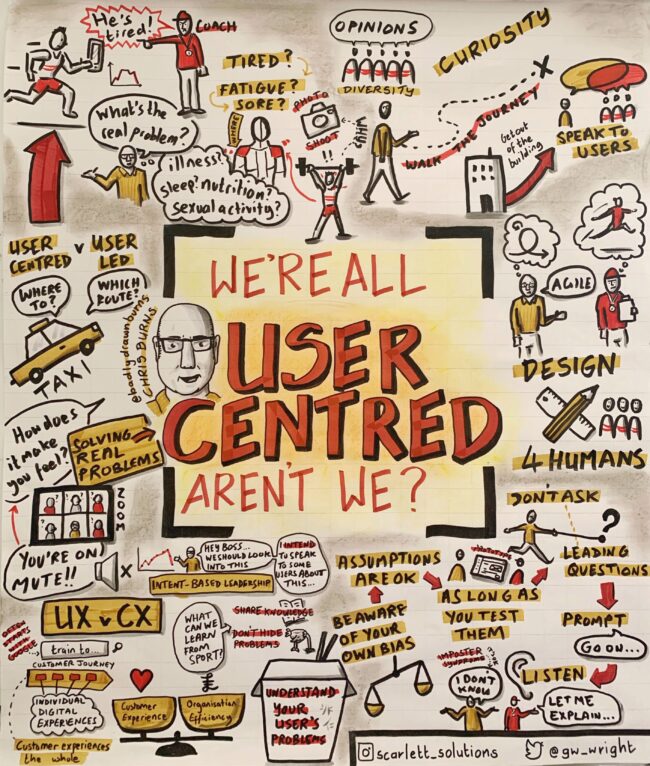
- How did you get into using visual thinking and sketch noting?
I used to really enjoy art when I was a child but as an adult I hadn’t sketched anything for years apart from the odd doodle on a whiteboard! But about 5 or 6 years ago I discovered “The Sketchnote Handbook” by Mike Rohde and I just loved the style of it (the book is made up of a series of sketchnotes that explain the concept of sketchnoting!). I gradually started to introduce visuals into my notes from podcasts, meet-ups and conferences. Initially I did this just for my own benefit, but then I got a bit braver and decided to share my sketches on social media where I discovered a really supportive community of visual thinkers who were willing to offer me lots of tips and advice on how to improve my sketching skills. Having practiced a lot and grown in confidence I now use visual thinking as an integral part of my consulting work and I also now teach others how to do it.
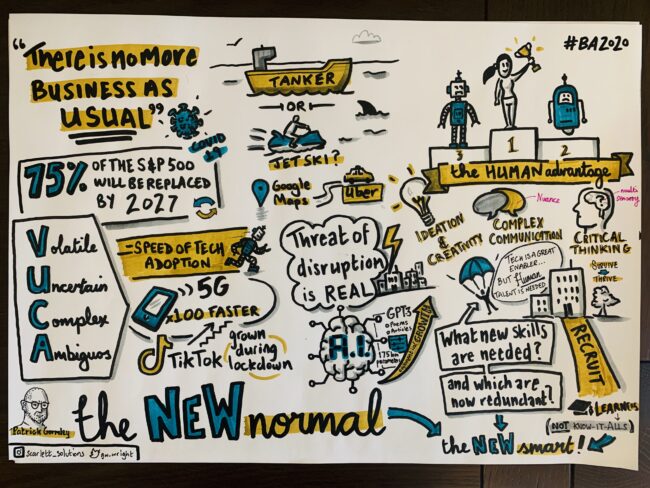
- What have the benefits been of using these techniques?
So the benefits can be wide ranging depending on the context in which Visual Thinking is used, but I quite like how Todd Cherches summarises them: Attention, Comprehension & Retention.
Attention – you can use visuals to grab and hold people’s attention or make content more accessible and easier to understand. For example, in the current climate we see a lot of simple visuals being used to help reinforce key messages about how to stay safe.
Comprehension – you can use visuals to externalise your thoughts and make connections that are much harder to see using your mind alone. It is said that if you cannot express something in a simple picture then you do not truly understand it. I certainly find that by sketching out my understanding it allows others to literally see what I am thinking, which results in a much richer conversation and invites them to validate my thoughts and fill in any gaps.
Retention – visuals can also be used to help with learning in order to improve our ability to retain and recall information. In fact, there are a number of scientific studies that show that we are able to consume visual information more quickly and easily than the verbal equivalent. Furthermore, when we consume information visually it significantly increases our ability to accurately recall it at a later date.
I have also added a fourth category of my own, which is Exploration…which also creates a nice acronym – ACRE! This is where you can use visuals to help generate ideas and spark creativity. A lot of Design Thinking and CX/UX techniques fall into this category and can be amplified by expressing information in a visual way (for example through a storyboard or a vignette sketch).
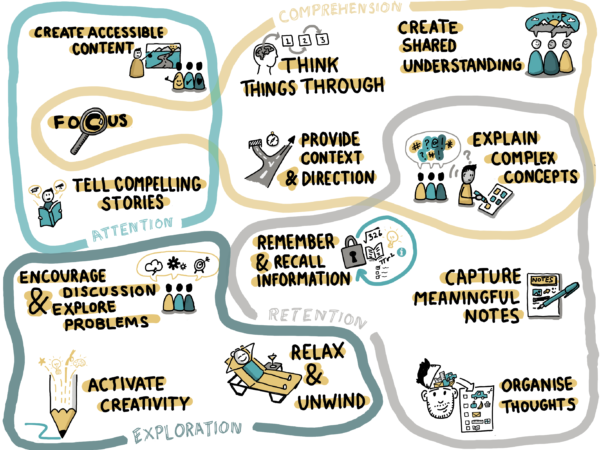
- What tools or software do you need?
I work in both digital and analogue forms and I sometimes even combine the two!
For digital work I use my iPad Pro and Apple Pencil. The two main apps I use are ‘Paper’ by WeTransfer and ‘Procreate’. ‘Paper’ is kept deliberately simple by its designers which means it is easy to pick up and get started, whereas Procreate has more advanced features such as layers, masking & animation but is a little trickier to get to grips with. I tend to go digital when I am producing content for presentations or when I’m creating longer lasting visuals that I may want to refine or build up over time.
For analogue sketches I love Neuland products, they offer a great range of pens & markers for both smaller scale sketchnotes and larger scale graphic recording & facilitation. But you can get started with pretty much any black technical pen or sharpie and some highlighters or brush pens for shade & colour.
When I’m training or facilitating remotely I like to use my IPEVO document camera which allows me to draw live in an analogue way whilst connecting with participants virtually! I also use virtual whiteboard or canvas tools such as Mural, Miro or Google Jamboard to support group facilitation or sharing of ideas.
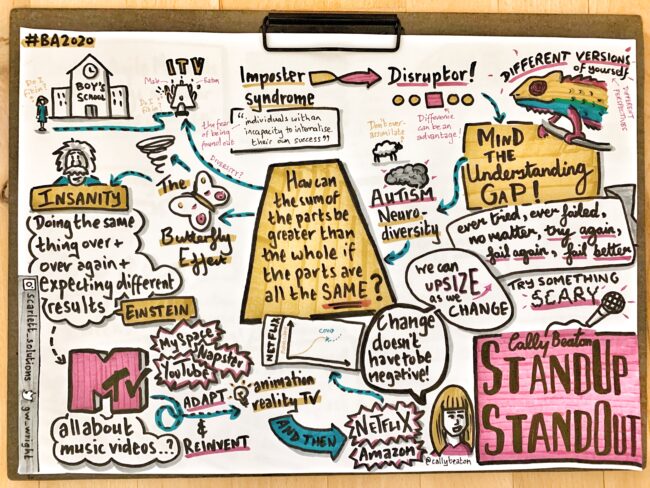
- What are your tips for starting out using these techniques?
My biggest tip from a sketchnoting perspective isn’t about drawing, it is about planning your approach, actively listening and synthesizing what you hear. If you know you are going to be listening to a 40 minute webinar then you can mentally divide up your canvas into 4 x 10 minute sections. You can also pre-draw a title or central image for your sketchnote if you know what the subject is going to be about in advance. You can even think about what icons might be useful given the topic that is going to be covered (e.g. what images might be useful for a talk about the future of digital technology and AI?). When it comes to the actual event the most important thing is the ability to focus and filter the key messages, you can even just capture the key words or quotes live and leave space to decorate your notes with icons, images and colour after the event.
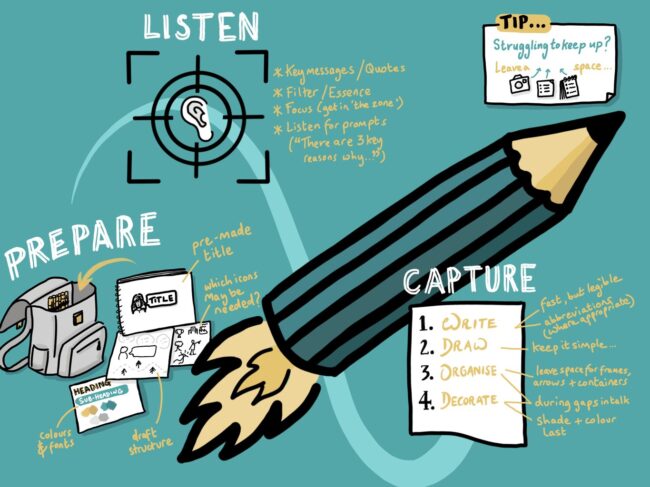
In terms of the drawing side of things I would recommend having a go at building your own icon library so that you have a dozen or so images that you are likely to use regularly and you feel comfortable drawing. If you follow hashtags on instagram such as #sketchnotes #visualthinking #doodles etc you will find lots of people that share ‘how to’ posts for free!
There are also a number of visual thinking meet-ups that you can attend, many of which are running online events at the moment. I run one with my co-host Paddy Dhanda called ‘The Visual Jam’ (https://www.meetup.com/TheVisualJam/) which was originally intended to be a local Midlands meetup in the UK, but due to COVID it has turned into an international virtual community with members tuning in from far away places such as Japan, Peru and Australia to name just a few! We have had some amazing guests and have many more lined up so that is another great way to hear from the experts in the field of Visual Thinking and learn some new skills along the way.
- How can readers find out more about you?
You can find me on LinkedIn (https://www.linkedin.com/in/grantwwright/ and www.linkedin.com/company/scarlett-solutions-limited), Instagram (https://www.instagram.com/scarlett_solutions/) and twitter (https://twitter.com/gw_wright).
You can also join in with The Visual Jam (https://www.meetup.com/TheVisualJam/) which also has a presence of Instagram (https://www.instagram.com/thevisualjam/) and twitter (https://twitter.com/TheVisualJam).
I am particularly keen to connect with Business Analysis / Architecture managers who are seeking to amplify their BA practice through the application of visual thinking as we offer unique training and consultancy in this space.
